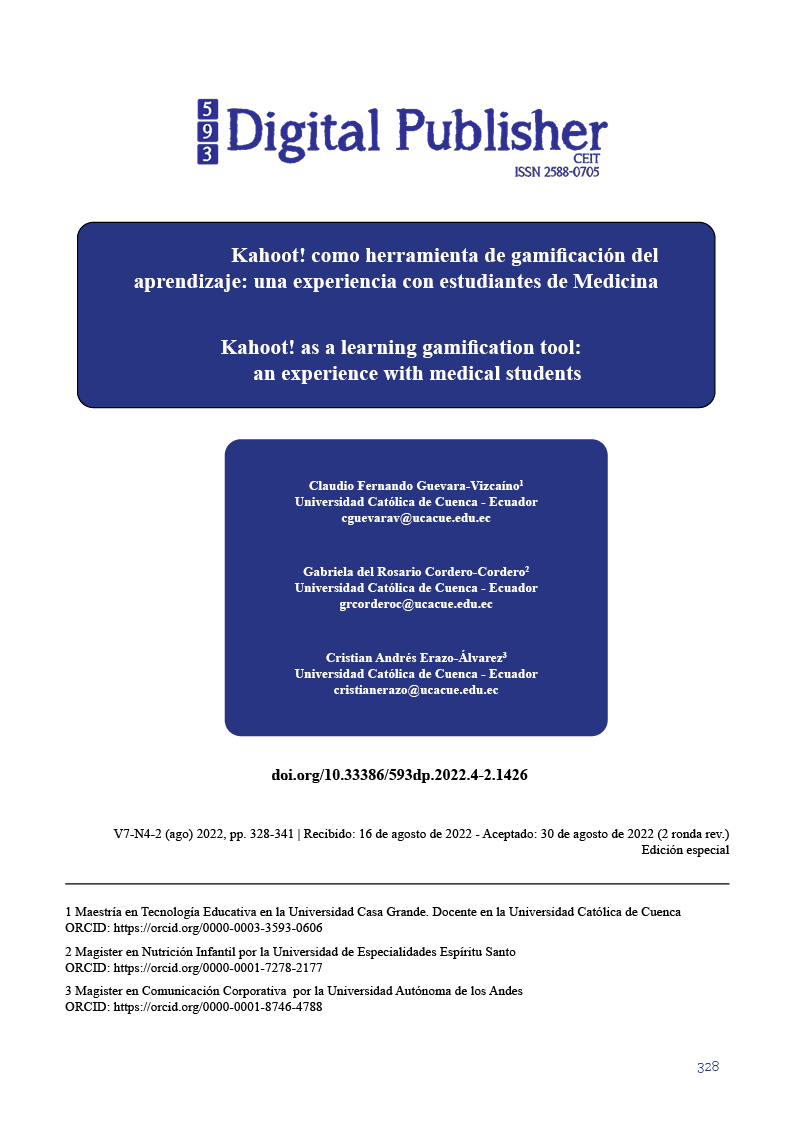Kahoot! as a learning gamification tool: an experience with medical students
Main Article Content
Abstract
The objective of this study was to analyze the perception of medical students regarding the use of Kahoot as a learning gamification tool. A quantitative, non-experimental cross-sectional study was carried out, which included a representative sample of 97 first-cycle students, of the Medicine career of the Catholic University of Cuenca [UCACUE]-Azogues Headquarters. To fulfill this task, a structured survey adjusted according to the local reality was applied. The instrument was structured in five categories: (1) commitment, (2) concentration, (3) motivation and competence, (4) learning, (5) fun and enjoyment. In order to guarantee the internal consistency of the instrument, it was submitted to expert judgment and validation by means of Cronbach's Alpha coefficient, obtaining a reliability of 0.758. Among the main results, it was possible to show that students perceive Kahoot as a tool that keeps them motivated, committed, and that, accompanied by the competitive element, stimulates their individual and collaborative participation. Finally, it is concluded that the use of this type of gamification tools should be extended to other subjects to establish a better environment in the classroom and strengthen academic performance.
Downloads
Article Details

This work is licensed under a Creative Commons Attribution-NonCommercial-ShareAlike 4.0 International License.
1. Derechos de autor
Las obras que se publican en 593 Digital Publisher CEIT están sujetas a los siguientes términos:
1.1. 593 Digital Publisher CEIT, conserva los derechos patrimoniales (copyright) de las obras publicadas, favorece y permite la reutilización de las mismas bajo la licencia Licencia Creative Commons 4.0 de Reconocimiento-NoComercial-CompartirIgual 4.0, por lo cual se pueden copiar, usar, difundir, transmitir y exponer públicamente, siempre que:
1.1.a. Se cite la autoría y fuente original de su publicación (revista, editorial, URL).
1.1.b. No se usen para fines comerciales u onerosos.
1.1.c. Se mencione la existencia y especificaciones de esta licencia de uso.
References
Aguiar, B. O., Velázquez, R. M., & Aguiar, J. L. (2019). Innovación docente y empleo de las TIC en la Educación Superior. Espacios, 40(2), 8. https://n9.cl/io6p
Aguilar Gordón, F. del R. (2020). From face-to-face learning to virtual learning in pandemic times. Estudios Pedagogicos (Valdivia), 46(3), 213-223. https://doi.org/10.4067/S0718-07052020000300213
Carbache Mite, E. (2020). Uso de la gamificación como estrategia didáctica en los niños y niñas de 7o año de educación básica en el área de estudios sociales de la unidad educativa fiscal Juan Montalvo [Pontificia Universidad Católica del Ecuador]. https://n9.cl/5821g
Comisión Económica para América Latina y el Caribe, [CEPAL]. (2020). La educación en tiempos de la pandemia de COVID-19. En Geopolitica(s). https://doi.org/10.5209/GEOP.69137
Da Silva, J. B., Andrade, M. H., Rodrigues De Oliveira, R., Leite Ventas, G., & Vieira Alves, F. (2018). Tecnologias digitais e metodologias ativas na escola: o contributo do Kahoot! para gamificar a sala de aula. Revista Thema, 15(2), 780-791. https://doi.org/10.15536/THEMA.15.2018.780-791.838
Gabarda Méndez, V., Colomo Magaña, E., & Romero Rodrigo, M. (2019). Metodologías didácticas para el aprendizaje en línea. 2012, 19-36. https://n9.cl/muaz6
Gándara-Vila, P., Blanco-Carrión, A., Peréz Sayáns, M., Reboiras-López, D., & Gallas-Torreira, M. M. (2021). Percepción de los estudiantes del grado de Odontología sobre la utilización de un sistema de respuesta interactiva (Kahoot®) Perception of students in dentistry degree on the use of an interactive response system (Kahoot®). FEM: Revista de la Fundación Educación Médica, 24(3), 113-119. https://doi.org/https://dx.doi.org/10.33588/fem.243.1122
Giménez Leal, G., & de Castro Vila, R. (2020). Dispositivos Móviles en Educación Superior: la experiencia con Kahoot! 70, 5-18. https://doi.org/https://doi.org/10.37610/dyo.v0i70.565
Gómez-Torres, M. J., Sáez Espinosa, P., Robles-Goméz, L., Huerta Retamal, N., Romero, A., & Velasco, I. (2018). ¡Kahoot! Como instrumento de refuerzo en Biologia del Desarrollo. En El compromiso académico y social a través de la investigación e innovación educativas en la Enseñanza Superior (pp. 1085-1095). http://rua.ua.es/dspace/handle/10045/88030
Holbrey, C. E. (2020). Kahoot! Using a game-based approach to blended learning to support effective learning environments and student engagement in traditional lecture theatres. Technology, Pedagogy and Education, 29(2), 191-202. https://doi.org/10.1080/1475939X.2020.1737568
Ismail, M. A.-A., & Mohammad, J. A.-M. (2017). Kahoot!: A Promising Tool for Formative Assessment in Medical Education. Education in Medicine Journal, 9(2), 19-26. https://doi.org/10.21315/eimj2017.9.2.2
Ledo Rubio, A. I., de la Gándara, J., García Alanso, M. I., & Gordo Seco, R. (2016). Videojuegos y salud mental: de la adicción a la rehabilitación . Cuadernos de medicina psicosomática y psiquiatria de enlace, 117, 72-83. https://n9.cl/2ihct
Licorish, S. A., Owen, H. E., Daniel, B., & George, J. L. (2018). Students’ perception of Kahoot!’s influence on teaching and learning. Research and Practice in Technology Enhanced Learning, 13(1). https://doi.org/10.1186/s41039-018-0078-8
Lofti, T. M., & Pratolo, B. W. (2021). Students’ Perceptions Toward The Use of Kahoot! Online Game for Learning English. Ethical Lingua, 8(1), 276-284. https://n9.cl/xqdsp
López Rodríguez, I., Raidell, I., Martínez, A., Baute Álvarez, L. M., Vidal, M., & Ii, L. (2018). Juegos digitales en la educación superior Videogames in higher education. Educación Médica Superior, 32(1), 264-276. https://n9.cl/c9dro
Magadan-Diaz, M., & Rivas-Garcia, J. I. (2022). Classroom gamification in online higher education: The use of Kahoot!. Campus Virtuales, 11(1), 137-152. https://doi.org/10.54988/cv.2022.1.978
Maraza Quispe, B., Cuadros Paz, L., Fernandez Gambarini, W., Alay Palomino, Y., & Chillitupa Quispihuanca, A. (2019). Análisis de las herramientas de gamificación online Kahoot! y Quizizz en el proceso de retroalimentación de aprendizajes de los estudiantes . Revista Referencia Pedagógica, 7(2), 339-362. https://n9.cl/a8k6l
Martínez Navarro, G. (2017). Tecnologías y nuevas tendencias en educación: Aprender jugando. El caso de Kahoot!. Opcion, 33(83), 252-277. https://n9.cl/gxt0u
Mawyin-Cevallos, F. A., Gutiérrez-Santana, J. A., Intriago-Cedeño, M. E., Zambrano-Zambrano, N. L., & Santana-Sardi, G. A. (2021). Análisis de criterio sobre la tecnología de la información y comunicación como herramienta de apoyo en la comunicación educativa universitaria. FIPCAEC, 6(23), 977-995. https://n9.cl/22zoz
Morales, A., & Orgilés, M. (2019). El uso de Kahoot! como recurso de evaluación continua en el Grado en Psicología. En Investigación e innovación en la Enseñanza Superior. Nuevos contextos, nuevas ideas (pp. 332-342). https://n9.cl/fqayw
Pegalajar Palomino, M. del C. (2021). Implications of gamification in Higher Education: A systematic review of student perception. Revista de Investigacion Educativa, 39(1), 169-188. https://doi.org/10.6018/RIE.419481
Pintor, E., Gargantilla, P., Herreros, B., & López del Hierro, M. (2014). Kahoot! en docencia: una alternativa practica a los clickers. XI Jornadas Internacionales de Innovación Universitaria. Educar para Transformar, 322-329. http://hdl.handle.net/11268/3603
Plump, C. M., & LaRosa, J. (2017). Using Kahoot! in the Classroom to Create Engagement and Active Learning: A Game-Based Technology Solution for eLearning Novices: Management Teaching Review, 2(2), 151-158. https://doi.org/10.1177/2379298116689783
Ramírez Covarrubias, A., Arciniega Luna, A., Iriarte Solís, A., & Arriaga Nabor, M. O. (2017). Aplicaciones educativas para la enseñanza: Caso de estudio Kahoot! . Revista Educateconciencia, 16(17), 139-149. https://n9.cl/yet83
Rojas-Viteri, J., Álvarez-Zurita, A., & Bracero-Huertas, D. (2021). Uso de Kahoot! como elemento motivador en el proceso enseñanza-aprendizaje. Cátedra, 4(1), 98-114. https://doi.org/10.29166/catedra.v4i1.2815
Saleem, A. N., Noori, N. M., & Ozdamli, F. (2022). Gamification Applications in E-learning: A Literature Review. Technology, Knowledge and Learning, 27, 139-159. https://doi.org/10.1007/S10758-020-09487-X
Sempere Ferre, F. (2018). Kahoot! como herramienta de autoevaluación en la universidad. En Congreso In-Red. https://doi.org/10.4995/INRED2018.2018.8730
Trejo González, H. (2019). Recursos tecnológicos para la integración de la gamificación en el aula. Tecnología, Ciencia y Educación, 13, 75-117. https://n9.cl/2ctz9
Vargas, I., & Hernandez, M. (2016). Kahoot!. https://n9.cl/ywr22




